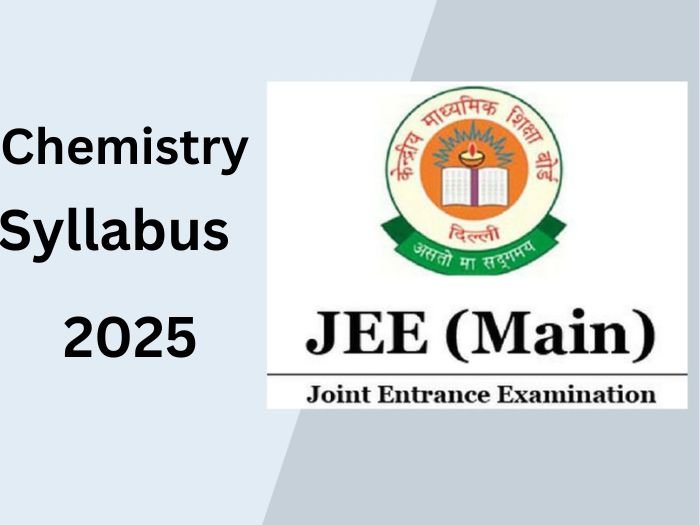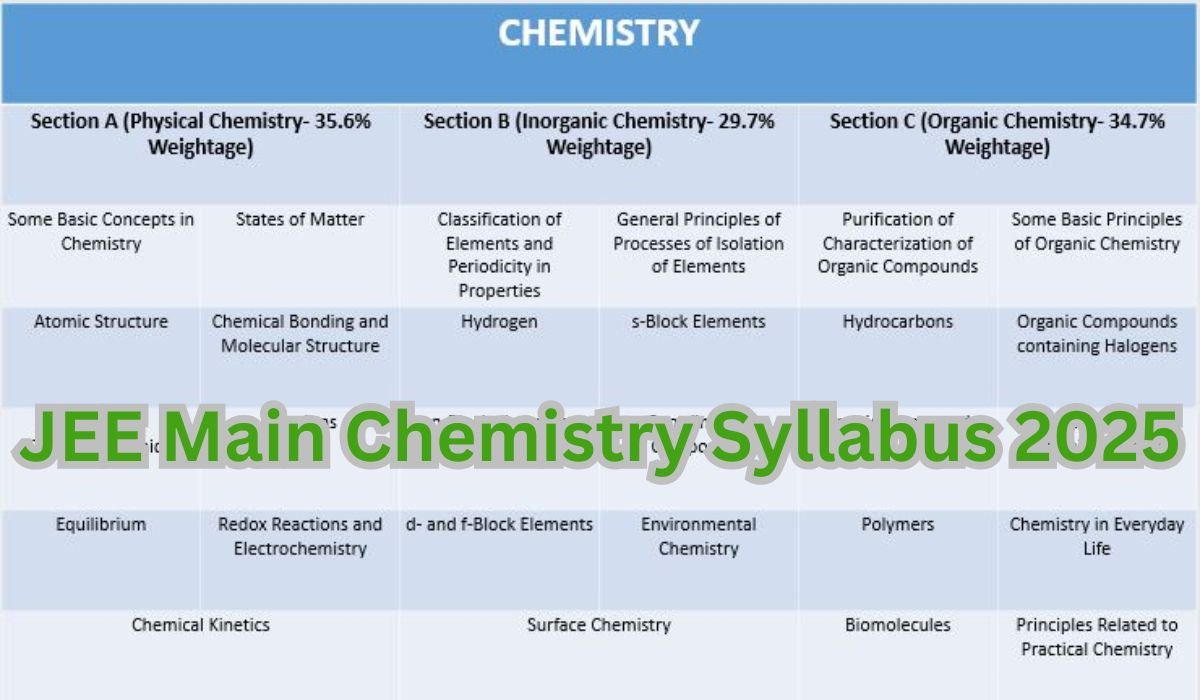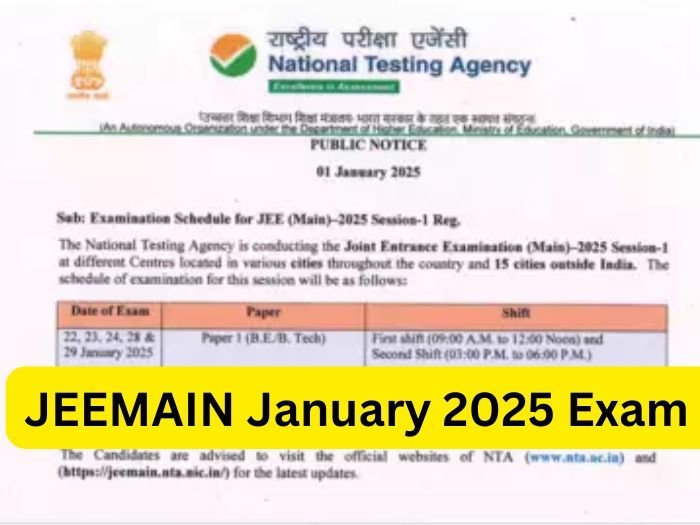JEE Main Syllabus Chemistry 2025: The National Testing Agency released the JEE Main Chemistry syllabus 2025 on its official website, jeemain.nta.nic.in. This page contains the JEE Mains Chemistry Syllabus pdf 2025.
JEE Main Chemistry Syllabus 2025
The JEE Chemistry syllabus includes topics in organic, physical, and inorganic chemistry. These are all required for the JEE mains exam. The National Testing Agency is conducting the JEE main 2025 session one exam on January 22, 23,24, 28, and 29 For B.E./B. Tech, the exam will be held on January 30, 2025.
Candidates should also refer to the 2025 JEE Main Syllabus chapter-wise in order to focus on important topics. The JEE mains exam pattern was also made available online. The article contains the entire JEE Main Chemistry 2025 syllabus.

JEE Mains Chemistry Syllabus 2025
The official website jeemain.nta.nic.in has published the JEE Main Chemistry 2025 syllabus. To cover the JEE Mains Chemistry curriculum, candidates must use the NCERT Books. The IIT JEE Chemistry Syllabus with Weightage 2025 will help candidates prepare for the most important topics. Below is the JEE Mains 2025 chemistry syllabus for Physical, Inorganic, and Organic Chemistry.
IIT JEE Main Physical Chemistry syllabus 2025: Section A
The IIT JEE Main Section A Physical Chemistry Syllabus covers topics like Atomic Structures, Chemical Bondings, Solutions, and Chemical Kinetics.
| Units | Chemistry Topics |
| Some Basic Concepts in Chemistry | Matter and its nature, Dalton’s atomic theory; Concept of atom, molecule, element, and compound; Laws of chemical combination: Atomic and molecular masses, mole concept, molar mass, percentage composition, empirical and molecular formulae; Chemical equations and stoichiometry. |
| Atomic Structure | Nature of electromagnetic radiation, photoelectric effect, spectrum of the hydrogen atom, Bohr model of a hydrogen atom – its postulates, derivation of the relations for the energy of the electron and radii of the different orbits, limitations of Bohr’s model, dual nature of matter, de Broglie’s relationship, Heisenberg uncertainty principle, elementary ideas of quantum mechanics, the quantum mechanical model of the atom and its important features, concept of atomic orbitals as one-electron wave functions, variation of Ψ and Ψ2 with r for 1s and 2s orbitals, various quantum numbers (principal, angular momentum and magnetic quantum numbers) and their significance, shapes of s, p and d – orbitals, electron spin and spin quantum number, rules for filling electrons in orbitals – Aufbau principle, Pauli’s exclusion principle and Hund’srule, electronic configuration of elements and extra stability of half-filled and completely filled orbitals. |
| Chemical Bonding and Molecular Structure | Kossel-Lewis approach to chemical bond formation, the concept of ionic and covalent bonds.Ionic Bonding: Formation of ionic bonds, factors affecting the formation of ionic bonds; calculationoflattice enthalpy.Covalent Bonding: Concept of electronegativity, Fajan’s rule, dipole moment, Valence Shell Electron Pair Repulsion (VSEPR ) theory and shapes of simple molecules. Quantum mechanical approach to covalent bonding: Valence bond theory – its important features, the concept of hybridization involving s, p and d orbitals, resonance. Molecular Orbital Theory – Its important features, LCAOs, types of molecular orbitals (bonding, antibonding), sigma and pi-bonds, molecular orbital electronic configurations of homonuclear diatomic molecules, the concept of bond order, bond length and bond energy. Elementary idea of metallic bonding, hydrogen bonding and its applications. |
| Chemical Thermodynamics | Fundamentals of thermodynamics: System and surroundings, extensive and intensive properties, state functions, entropy, types of processes. The first law of thermodynamics – Concept of work, heat, internal energy and enthalpy, heat capacity, molar heat capacity, Hess’s law of constant heat summation, Enthalpies of bond dissociation, combustion, formation, atomization, sublimation, phase transition, hydration, ionisation and solution. The second law of thermodynamics – Spontaneity of processes, ΔS of the universe and ΔGof the system as criteria for spontaneity. ΔG°(Standard Gibbs energy change) and equilibrium constant. |
| Solutions | Different methods for expressing the concentration of solution – molality, molarity, mole fraction, percentage (by volume and mass both), the vapour pressure of solutions and Raoult’s Law- Ideal and nonideal solutions, vapour pressure – composition, plots for ideal and non- ideal solutions, Colligative properties of dilute solutions – a relative lowering of vapour pressure, depression of freezing point, the elevation of boiling point and osmotic pressure, determination of molecular mass using colligative properties, abnormal value of molar mass, van’t Hoff factor and its significance. |
| Equilibrium | Meaning of equilibrium is the concept of dynamic equilibrium. Equilibria involving physical processes: Solid-liquid, liquid-gas, gas-gas and solid-gas equilibria, Henry’s law. General characteristics of equilibrium involving physical processes. Ionic equilibrium: Weak and strong electrolytes, ionisation of electrolytes, various concepts of acids and bases (Arrhenius, Bronsted – Lowry and Lewis) and their ionisation, acid-base equilibria (including multistage ionisation) and ionisation constants, ionisation of water, pH scale, common in effect, hydrolysis of salts and pH of their solutions, the solubility of sparingly soluble salts, solubility products and buffer solutions. |
| Redox Reactions and Electro-chemistry | Electronic concepts of oxidation and reduction, redox reactions, oxidation number, rules for assigning oxidation number and balancing of redox reactions.Electrolytic and metallic conduction, conductance in electrolytic solutions, molar conductivities and their variation with concentration, Kohlrausch’s law and its applications. Electrochemical cells – Electrolytic and Galvanic cells, different types of electrodes, electrode potentials including standard electrode potential, half-cell and cell reactions, emf of a Galvanic cell and its measurement, Nernst equation and its applications, relationship between cell potential and Gibbs’ energy change, dry cell and lead accumulator, fuel cells |
| Chemical Kinetics | Rate of a chemical reaction, factors affecting the rate of reactions: concentration, temperature, pressure and catalyst, elementary and complex reactions, order and molecularity of reactions, rate law, rate constant and its units, differential and integral forms of zero and first-order reactions, their characteristics and half-lives, the effect of temperature on the rate of reactions, Arrhenius theory, activation energy and its calculation, collision theory of bi-molecular gaseous reactions (no derivation). |
Inorganic Chemistry chapters for Section B 2025
The Inorganic Chemistry syllabus of JEE Mains section B includes topics like the Periodic Table, Chemical Bonding, and Coordination Compounds.
| Classification of Elements and Periodicity in Properties | Modern periodic law and present form of the periodic table, s, p. d and f block elements, periodic trends in properties of elements atomic and ionic radii, ionisation enthalpy, electron gain enthalpy, valence, oxidation states and chemical reactivity |
| p- Block Elements | Group -13 to Group 18 Elements- General Introduction: Electronic configuration and general trends in physical and chemical properties of elements across the periods and down the groups, unique behaviour of the first element in each group. Groupwise study of the p – block elements Group -13- Preparation, properties and uses of boron and aluminium; Structure, properties and uses of borax, boric acid, diborane, boron trifluoride, aluminium chloride and alums. Group -14- Tendency for catenation; Structure, properties and uses of Allotropes and oxides of carbon, silicon tetrachloride, silicates, zeolites and silicones. Group -15- Properties and uses of nitrogen and phosphorus; Allotropic forms of phosphorus; Preparation, properties, structure and uses of ammonia, nitric acid, phosphine and phosphorus halides, (PC13, PCI,); Structures of oxides and oxoacids of nitrogen and phosphorus. Group -16 Preparation, properties, structures and uses of ozone; Allotropic forms of sulphur; Preparation, properties, structures and uses of sulphuric acid (including its industrial preparation); Structures of oxoacids of sulphur. Group -17- Preparation, properties and uses of hydrochloric acid; Trends in the acidic nature of hydrogen halides; Structures of Interhalogen compounds and oxides and oxoacids of halogens.Group-18- Occurrence and uses of noble gases; Structures of fluorides and oxides of xenon. |
| d – and f – Block Elements | Transition Elements – General introduction, electronic configuration, occurrence and characteristics, general trends in properties of the first-row transition elements – physical properties, ionisation enthalpy, oxidation states, atomic radii, colour, catalytic behaviour, magnetic properties, complex formation, interstitial compounds, alloy formation, preparation, properties and uses of K2Cr2O7 and KMnO4.Inner Transition ElementsL anthanoids – Electronic configuration, oxidation states and Lanthanoid contraction. Actinoids – Electronic configuration and oxidation states. |
| Co-Ordination Compounds | Introduction to coordination compounds. Werner’s theory, ligands, coordination number, denticity, chelation, IUPAC nomenclature of mononuclear co-ordination compounds, isomerism, Bonding: Valence bond approach and basic ideas of Crystal field theory, colour and magnetic properties, importanceofcoordination compounds (in qualitative analysis, extraction of metals and in biological systems). |
Read this also – Shivaji University Result 2025 Out, Check SUK Results Download Link, Details Check Here
JEE Mains Chemistry syllabus 2025: Organic Chemistry Section C
The Organic Chemistry syllabus of JEE Mains Section C 2025 includes important topics such as Organic Compounds and Hydrocarbons.
| Purification and Characterization of Organic Compounds | Purification – Crystallisation, sublimation, distillation, differential extraction and chromatography-principles and their applications. Qualitative analysis – Detection of nitrogen, sulphur, phosphorus and halogens. Quantitative analysis (basic principles only) – Estimation of carbon, hydrogen, nitrogen, halogens, sulphur and phosphorus. Calculations of empirical formulae and molecular formulae, numerical problems in organic quantitative analysis, |
| Some Basic Principles of Organic Chemistry | Tetravalency of carbon, shapes of simple molecules – hybridization (s and p): classification of organic compounds based on functional groups and those containing halogens, oxygen, nitrogen and sulphur, homologous series: Isomerism – structural and stereoisomerism Nomenclature (Trivial and IUPAC) Covalent bond fission – Homolytic and heterolytic, free radicals, carbocations and carbanions, stability of carbocations and free radicals, electrophiles and nucleophiles Electronic displacement in a covalent bond – Inductive effect, electromeric effect, resonance and hyperconjugation. Common types of organic reactions- Substitution, addition, elimination and rearrangement. |
| Hydrocarbons | Classification, isomerism, IUPAC nomenclature, general methods of preparation, properties and reactions. Alkanes – Conformations: Sawhorse and Newman projections (of ethane), mechanism of halogenationofalkanes. Alkenes – Geometrical isomerism, mechanism of electrophilic addition, addition of hydrogen, halogens, water, hydrogen halides (Markowni koffs and peroxide effect), Ozonolysis and polymerization. Alkynes – Acidic character, addition of hydrogen, halogens, water and hydrogen halides, polymerization. Aromatic hydrocarbons – Nomenclature, benzene – structure and aromaticity, mechanism of electrophilic substitution, halogenation, nitration. Friedel-Craft’s alkylation and acylation, directive influence of the functional group in mono- substituted benzene. |
| Organic Compounds Containing Halogens | General methods of preparation, properties and reactions, nature of C-X bond, mechanisms of substitution reactions. Uses, environmental effects of chloroform, iodoform, freons and DDT |
| Organic Compounds Containing Oxygen | General methods of preparation, properties, reactions and uses. ALCOHOLS, PHENOLS AND ETHERS Alcohols: Identification of primary, secondary and tertiary alcohols, mechanism of dehydration .Phenols: Acidic nature, electrophilic substitution reactions, halogenation, nitration and sulphonation, Reimer – Tiemann reaction. Ethers: Structure. Aldehyde and Ketones: Nature of carbonyl group, nucleophilic addition to >C=Ogroup, relative reactivities of aldehydes and ketones, important reactions such as – Nucleophilic addition reactions(addition of HCN, NH3 and its derivatives), Grignard reagent, oxidation, reduction (Wolf Kushner and Clemmensen), the acidity of α -hydrogen. Aldol condensation, Cannizzaro reaction, Haloform reaction, chemical tests to distinguish between aldehydes and ketones. Carboxylic Acids: Acidic strength and factors affecting it. |
| Organic Compounds Containing Nitrogen | General methods of preparation, properties, reactions and uses. Amines: Nomenclature, classification, structure, basic character and identification of primary, secondary and tertiary amines and their basic character. Diazonium Salts: Importance in synthetic organic chemistry. |
| Biomolecules | General introduction and importance of biomolecules. Carbohydrates – Classification: aldoses and ketoses; monosaccharides (glucose and fructose) and constituent monosaccharides of oligosaccharides (sucrose, lactose, and maltose).PROTEINS – Elementary idea of α -amino acids, peptide bond, polypeptides, proteins: primary, secondary, tertiary and quaternary structure (qualitative idea only), denaturation of proteins, enzymes. Vitamins – Classification and functions. Nucleic Acids – Chemical constitution of DNA and RNA. Biological functions of nucleic acids. |
| Principles Related to Practical Chemistry | Detection of extra elements (N, S, halogens) in organic compounds; Detection of the following functional groups: hydroxyl (alcoholic and phenolic), carbonyl (aldehyde and ketone), carboxyl, and amino groups in organic compounds.• Chemistry involved in the preparation of the following: Inorganic compounds: Mohr’s salt, potash alum. Organic compounds: Acetanilide, p nitro acetanilide, aniline yellow, iodoform.• Chemistry involved in the titrimetric exercises -Acids bases and the use of indicators, oxalic-acid vs KMnO, Mohr’s salt vs KMnO,•Chemical principles involved in the qualitative salt analysis: Cations – Pb2+, Cu!+, Af,+, Fe1+, Zn2+, Ni2+, Ca2+, Ba2+,Mg2+, nh;.Anions- CO,”, S2~, SO4″, NO”, NO~2, Cf, Br”, I”. (Insoluble salts excluded).•Chemical principles involved in the following experiments:1. Enthalpy of solution of CuS042. Enthalpy of neutralisation of strong acid and strong base.3. Preparation of lyophilic and lyophobic sols.4. Kinetic study of the reaction of iodide ion with hydrogen peroxide at room temperature. |
Chemistry Syllabus with Weightage
| JEE Main Chemistry Syllabus with Weightage | ||
| Chapters | No. of Questions | Weightage |
| Mole Concept | 1 | 3.3% |
| Redox Reactions | 1 | 3.3% |
| Electrochemistry | 1 | 3.3% |
| Chemical Kinetics | 1 | 3.3% |
| Solution & Colligative Properties | 1 | 3.3% |
| General Organic Chemistry | 1 | 3.3% |
| Stereochemistry | 1 | 3.3% |
| Hydrocarbon | 1 | 3.3% |
| Alkyl Halides | 1 | 3.3% |
| Carboxylic Acids & their Derivatives | 1 | 6.6% |
| Carbohydrates, amino acids, and Polymers | 1 | 6.6% |
| Aromatic Compounds | 1 | 6.6% |
| Atomic Structure | 2 | 6.6% |
| Chemical Bonding | 2 | 6.6% |
| Chemical And Ionic Equilibrium | 2 | 6.6% |
| Solid-State And Surface Chemistry | 2 | 6.6% |
| Nuclear & Environmental Chemistry | 2 | 6.6% |
| Thermodynamics & the Gaseous State | 2 | 6.6% |
| Transition Elements & Coordination Compounds | 3 | 9.9% |
| Periodic table, p-Block Elements | 3 | 9.9% |
Read this also – ITBP PET PST Admit Card 2024-25 Out, Syllabus & Exam Pattern Check Here
JEE Mains Chemistry Syllabus 2025 Deleted
NTA will be removing several topics and units from the JEE Mains syllabus in 2024. The updated syllabus is provided in the above table. According to the official announcement released on jeemain.nta.nic.in, the chemistry syllabus was updated. The JEE Main syllabus for chemistry has been deleted.
In chemistry, physical quantities represent measurable properties of matter, such as mass, volume, temperature, and pressure. Accurate and precise measurement of these quantities is crucial for experimental reproducibility and reliable results.
- States of Matter
- Thomson and Rutherford atomic models and their limitations;
- Surface Chemistry
- S -block E=lements
- General Principles and Processes of Isolation of Metals
- Hydrogen
- Environmental Chemistry
- Polymers
- Chemistry in everyday life
Sample Papers for JEE Main 2025
Candidates should check. Their level of preparation by solving. The sample papers. And JEE main 2025 mock tests after they have studied the JEE 2025 chemistry syllabus pdf. The JEE Main sample papers follow the NTA JEE exam pattern and syllabus. The JEE main sample papers 2025. Along with the mock test. Is an excellent resource. That helps candidates. Improve their speed. And accuracy. During the exam.
Note – All the candidates. Are informed. That all the. Information related to. The syllabus is given in it.. Yet you should visit its official site once. After that you will not have to face any problems, thank you.






